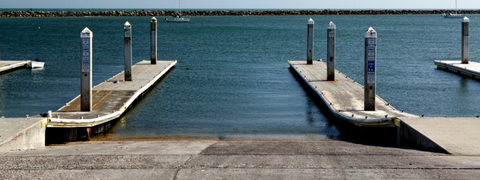How to Back Up a Boat Trailer
Backing up a boat trailer can be a daunting task for many boat owners, but with the right knowledge and techniques, it can be easily manageable. In this article, we'll cover everything you need to know about how to back up a boat trailer safely and effectively.
Understanding Boat Trailer Basics
Before we dive into the specifics of backing up a boat trailer, it's essential to understand the basics of boat trailers. There are different types of boat trailers, including bunk trailers, roller trailers, and pontoon trailers, each designed to support a specific type of boat.
Bunk trailers have a set of padded horizontal bunks that support the boat's hull, while roller trailers have a set of rollers that allow the boat to glide onto and off the trailer. Pontoon trailers have the capacity to support pontoons on either side of the trailer and the boat's deck resting on the frame in the center of the trailer.
It's important to choose the right type of trailer for your boat to ensure that it's supported correctly and safely during transportation. If you're unsure which type of trailer is best for your boat, consult with a professional or refer to the boat's manual.
Essential Components of a Boat Trailer
Regardless of the trailer type, boat trailers have specific essential components that work together to support and move the boat. These components include the frame, wheels and tires, hitch, axles, lights, and brakes (if equipped).
The frame is the main structure of the trailer and is responsible for supporting the boat's weight. The wheels and tires provide the necessary traction and support for the trailer to move smoothly on the road. The hitch connects the trailer to the towing vehicle, and the axles distribute the weight evenly across the trailer's wheels.
Lights are a crucial component of any trailer, as they allow other drivers to see the trailer and its contents on the road. Make sure to check that all lights are functioning correctly before hitting the road. Brakes are another essential component, especially for larger boats. They help the towing vehicle slow down and stop the trailer safely.
Safety Precautions Before Backing Up
Before backing up your boat trailer, it's essential to take safety precautions. First, ensure that the boat is securely attached to the trailer. Check that all straps and chains are properly fastened and that the boat is centered on the trailer.
Second, make sure that all tires are properly inflated, the lights are functioning, and the brakes (if equipped) are working correctly. Check the tire pressure with a gauge and inspect the tires for any signs of wear or damage.
Lastly, it's crucial to have someone assist you as a spotter. This person should stand outside the vehicle and guide you as you back up the trailer. Use hand signals to communicate, and make sure to go slowly and carefully.
By following these safety precautions and understanding the basics of boat trailers, you can ensure a safe and successful boating trip.
Boat Trailer Maintenance: Best Way to Wrap Bunk Boards with Bunk Carpet
Preparing Your Vehicle and Trailer for Backing Up
Backing up a vehicle with a trailer attached can be a daunting task, but with the right preparation and techniques, it can be done safely and efficiently. Once you've taken the necessary safety precautions, it's time to prepare your vehicle and trailer for backing up.
Aligning Your Vehicle and Trailer
The first step in preparing your vehicle and trailer for backing up is aligning them. Ideally, the trailer should be directly behind your vehicle, with the hitch ball and coupler aligning with each other. This will make it easier to maneuver the trailer as you back up.
However, if the trailer is not properly aligned, you can use a spotter to guide you into position. A spotter can stand behind the trailer and give you directions as you back up.
Adjusting Your Mirrors
Adjust your side mirrors so that you have a clear view of the sides and rear of your vehicle and trailer. This will help you make adjustments as needed as you back up. You can also use a backup camera if your vehicle is equipped with one.
It's important to note that while mirrors can be helpful, they may not give you a full view of your surroundings. Therefore, it's important to always check your blind spots and use caution when backing up.
Checking Your Surroundings
Before backing up, make sure the area behind you is clear. Check for any obstacles or people that may be in your way. If possible, back up in an open space. This will give you more room to maneuver the trailer and reduce the risk of accidents.
It's also a good idea to check the weather conditions before backing up. Windy conditions can make it more difficult to control the trailer, so it's important to be aware of any potential hazards.
By taking these steps to prepare your vehicle and trailer for backing up, you can help ensure a safe and successful experience. Remember to always use caution and take your time when maneuvering a trailer, and don't be afraid to ask for help if you need it.
Learn 10 Ways to Prepare your Boat Trailer for Boating Season
Mastering the Art of Backing Up
Backing up a boat trailer can be a daunting task for many boaters, especially those who are new to the sport. However, with the right preparation, techniques, and practice, anyone can learn to back up a boat trailer like a pro.
Before you begin, it's important to make sure that you have all the necessary equipment. This includes a hitch, a ball mount, safety chains, and a wiring harness. You should also check that your boat trailer is properly loaded and balanced, and that your vehicle is capable of towing the weight of the trailer.
Once you're prepared, it's time to start backing up your boat trailer. One of the most important things to remember is to take your time. Slow and steady movements will help you maintain control and avoid accidents.
Steering Techniques for Backing Up
When backing up, use small, gradual steering movements to turn the trailer in the desired direction. Remember to use your mirrors to guide your movements and adjust as necessary. It's also helpful to place your hand at the bottom of the steering wheel and move it in the direction you want the trailer to go.
Another useful technique is to imagine that the trailer is the back end of your vehicle. This can help you anticipate the movements you need to make and make adjustments accordingly.
Using a Spotter for Assistance
Having a spotter help guide you while backing up can be incredibly helpful. They can communicate with you when you need to adjust and prevent accidents. It's important to establish clear signals and communication before you begin backing up. For example, you might agree that one hand signal means "stop," while another means "turn left."
When choosing a spotter, look for someone who is reliable, calm, and has experience with backing up trailers. It's also helpful to choose someone who can see both the front and back of the trailer.
Practicing in an Open Space
Backing up a boat trailer can take time to master, and it's essential to practice in an open space before attempting to back up in tight spaces or around obstacles. Look for a large, empty parking lot or other open area where you can practice without worrying about other vehicles or pedestrians.
As you practice, pay attention to how the trailer responds to your movements. Try backing up in different directions and angles to get a feel for how the trailer moves. The more you practice, the more confident and comfortable you'll become.
Remember, backing up a boat trailer is a skill that takes time and practice to master. By following these tips and techniques, you'll be well on your way to becoming a pro at backing up your boat trailer.

Navigating Common Backing Up Scenarios
Backing up a trailer can be a challenging task, especially for beginners. It requires patience, practice, and a good understanding of the techniques involved. In the previous sections, we discussed the basics of backing up a trailer and some essential tips to keep in mind. Now, let's look at some common backing up scenarios you may encounter and how to handle them.
Backing Up into a Driveway
Backing up into a driveway can be tricky, especially if it's narrow or has obstacles on either side. To do it safely, approach the driveway slowly and straight-on. Make sure the trailer is aligned with the driveway before you start backing up. If necessary, get out of the vehicle and check the alignment.
Once you're ready to back up, turn the wheel in the direction you want the trailer to move. If you want the trailer to go left, turn the wheel left, and vice versa. Use small, smooth movements to avoid oversteering. Keep an eye on your mirrors and the trailer's position to ensure it stays on track.
If the trailer starts to jackknife, don't panic. Stop the vehicle and turn the wheel in the opposite direction to straighten it out. Slowly resume backing up and make any necessary adjustments to keep the trailer on course.
Launching Your Boat at a Ramp
When launching your boat, it's essential to take your time and do it right. Back the trailer down the ramp until the boat starts to float. Make sure the trailer is deep enough in the water to allow the boat to float off easily. If the water is shallow, you may need to back up further.
Once the boat is floating, slowly drive the trailer out of the water. Make sure to secure the boat to the dock before driving your vehicle away to park. Use straps or ropes to keep the boat in place and prevent it from drifting away. Check the security of the boat before leaving to ensure it won't move or tip over.
Reversing in Tight Spaces
Reversing in tight spaces can be challenging, but it's a skill that can be mastered with practice. Use small, smooth steering adjustments while moving your vehicle back and forth to turn the trailer in the desired direction. Remember to use your mirrors and spotter to guide your movements.
If you're reversing in a narrow space, take it slow and steady. Don't rush or try to force the trailer into position. Instead, make small adjustments and take breaks if necessary to avoid getting frustrated or overwhelmed.
With these tips and techniques, you'll be able to back up your boat trailer safely and effectively. Remember to take your time, practice, and always prioritize safety. Happy boating!

